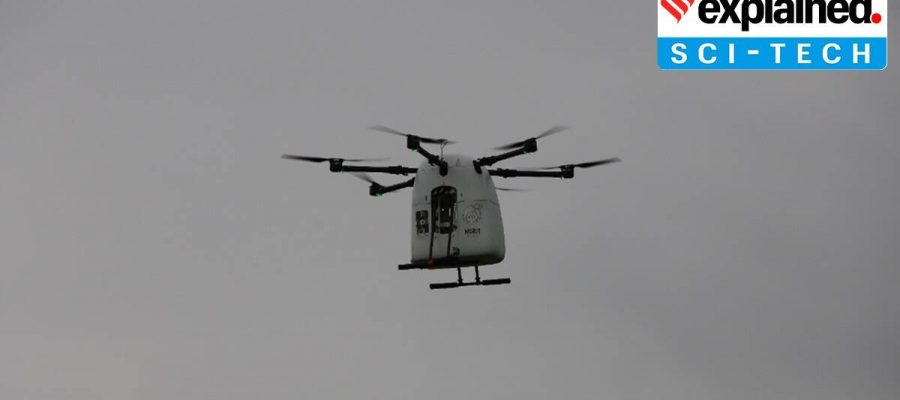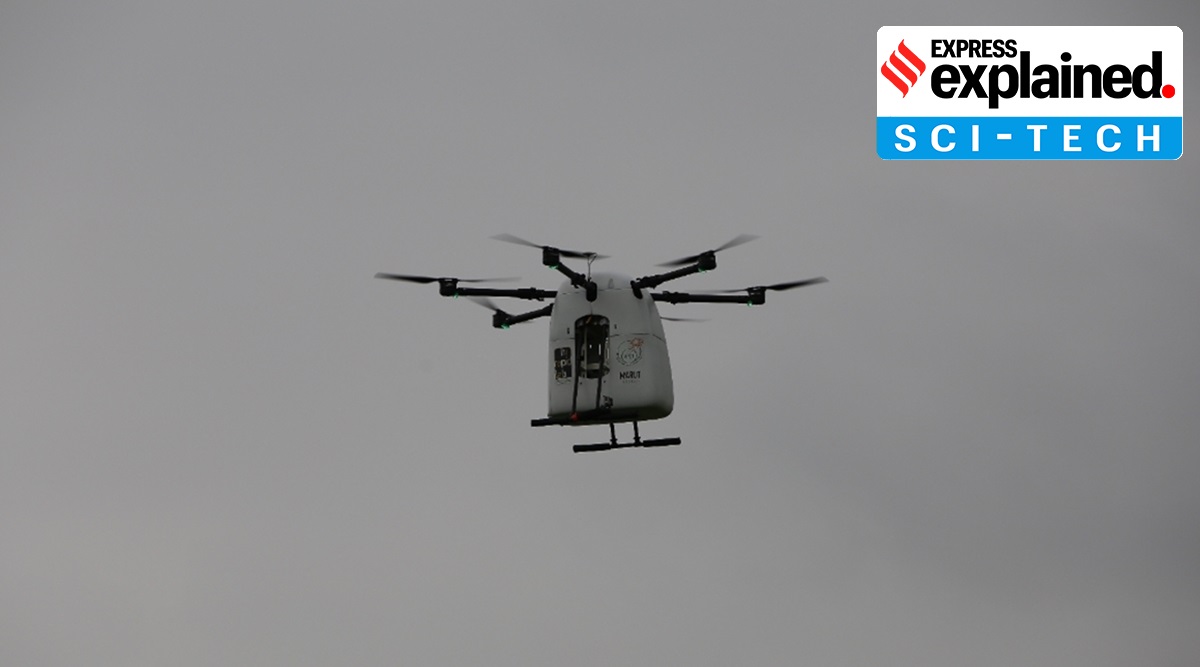Though drones have been used for photography, mapping, and other operations, the ongoing Coivd-19 pandemic has widened its scope beyond limits.
Telangana government’s ‘Medicine from the sky’ programme is all set for launch on September 11. Following a final regulatory nod from the Ministry of Civil Aviation (MoCA) to conduct operations, the launch event is scheduled in Vikarabad district.
Using drones as a mode of delivery to improve medical supply chains, the project aims to assess robustness and reliability of the same using different payload sizes, and in controlled temperatures, from distribution centers to specific locations and back. The payloads could be medicines, vaccines, units of blood, diagnostic specimens, and other lifesaving equipment. It further intends to assist policymakers and health systems to analyse the opportunities and challenges of drone delivery as well as competing delivery models and technologies.
What is ‘Medicine from the sky’ (MFTS)?
The project is led by the Emerging Technologies Wing of the state IT department in partnership with World Economic Forum, NITI Aayog, and HealthNet Global (Apollo Hospitals), and aims to undertake experimental Beyond Visual Line of Sight (BVLOS) drone flights for delivery of vaccines using the identified airspace of the Vikarabad district.
During the Wings 2020 event in Hyderabad last year, the Telangana government partnered with the World Economic Forum for the MFTS programme. An expression of interest (EOI) was released to assess the capability of drone service providers in providing safe, accurate, and reliable pickup and delivery of Health care items. Out of the 16 consortia (between logistics firms and drone operators) that had responded, 8 were shortlisted.
The project is the first-of-its-kind in India as it is the first organised BVLOS drone trials in the country and the same is being conducted in healthcare as the domain, said a release from minister KT Rama Rao’s office.
Ahead of the launch, three of the eight selected consortia namely Bluedart Med Express Consortium (Skye Air), Hepicopter Consortium (Marut Drones), and CurisFly Consortium (TechEagle Innovations) have reached Vikarabad and conducted test flights of their drones via VLOS and BVLOS. Following the launch, the consortia would continue to further test the endurance of their drones over longer distances and heavier payloads to establish reliability.
What’s the scope?
Though drones have been used for photography, mapping, and other operations, the ongoing Coivd-19 pandemic has widened its scope beyond limits. According to the plan, the consortia will demonstrate the utilisation of BVLOS flights in Vikarabad district with the Government Area Hospital as the take-off site and various PHCs and sub-centers as the landing sites. The private sector and start-up firms, through a collaboration with the state government, can be integrated into the government healthcare systems to ensure time and life-saving efforts compared to traditional delivery systems. In the case of the ongoing Covid vaccine inoculation drive, such a system can improve access to healthcare in rural and remote locations.
According to the Hepicopter consortium, one of the few to be selected for the project, India has the potential of using up to five UAVs or drones per district with a range of 40km and with a payload of 15 kg and endurance of two hours. With 718 districts in India, 3,600 drones can be deployed to distribute an effective weight of vaccines via each flight, or 15,000 kg vaccine distribution capability in a single day.
How does it work?
Speaking to indianexpress.com about the Hepicopter consortium, Prem Kumar Vislawath, founder and CEO of Marut Dronetech Private Limited, said an in-house app would allow the team at the pick-up point to receive a message about the required inventory from the drop-off location.
For example, the primary health center places a request via an app for vaccine supply or medicines from the district hospital and pick-up of samples in return. The team receives the message and loads the same at the drone’s central hub. The drone takes off after regular pre-flight tests and checks of wind conditions, audio pilot systems, and GPS tracker. The coordinates are fed into the systems and once the drone is about to land, the PHC gets a notification and the personnel can go and collect the package at the drop-off point by keying in an OTP. After the required pick-up for the return flight, the drone flies back notifying the app.
Marut Drones have developed a Hepicopter 1.0, which can handle a 10-kg payload and a maximum flight range of 15 km, endurance of 30 minutes, and a flying altitude of 400 feet. This drone can hold four boxes, each carrying up to 10 units of blood or over 500 doses of vaccines. So, on a single flight, they can deliver 2,000 to 3,000 doses of vaccines.
Another multi rotor-wing battery-powered drone, Hepicopter 2.0 is gasoline-powered and has a payload capacity of 5 kg, a maximum endurance limit of 80 mins, a range of 80 km, and a flying altitude of 400 ft – 12000 ft. This drone can hold two boxes and can carry up to 1,000 doses of vaccines. The drones are either autonomous or manually operated based on the design.
“The uniqueness in our drone is that it can carry multiple temperature-controlled boxes which can maintain different temperatures. Our drones are autonomous, can fly long distances carrying heavy payloads and we created an app to simplify the operations,” said Vislawath. On average, covering a distance of 25 km could take about 30 minutes.
Other partners in the consortium are the Public Health Foundation of India (PHFI), Hi Rapid Lab, and Alpha Design Technologies.
Challenges and further opportunities
Swapnik Jakkampudi, Co-Founder, Skye Air Mobility, told indianexpress.com that the project is a big step for established logistics companies to partner with startups to leverage technology, speed up processes and solve problems. Skye Air is the drone delivery partner for logistics firms Blue Dart, Flipkart, and Dunzo for three consortia. “We are starting with Blue Dart for a week and a week each for the other two partners. The criteria and demands are different. They come with different experiences and have different sectors as focus. Our drones can fly a distance of up to 10 km carrying up to a 5 kg payload. Seven or eight trips are possible in a day.”
The biggest challenge till now has been to understand the permissions and regulations. And drone delivery will be a game-changer very soon due to advancements in aerial technology, favourable government policy, and positive mindset of people, said Jakkampudi. The biggest outcome of this project would be that other governments and private players will be able to learn from this experience enabling the industry to move forward. While drones are being put into use for the healthcare sector which is the need of the hour, the next big disruption will be the use of drones in e-commerce.
Principal Secretary (IT, E&C) to the Telangana government, Jayesh Ranjan said the project is Telangana’s contribution to the country to showcase a model where drones can be used in some needy areas. “Already we are using drones in many areas such as recently seed balls are being dropped from the sky for planting trees in forest areas, we are using drones for the survey of mines. This (project) is to showcase the possibilities that technology can create. Currently, the focus is on healthcare requirements- vaccines, medicines, blood, etc. Any remote and inaccessible areas can be reached,” he said.
According to Hepicopter, the current class of drones can support vaccination in remote areas by safely transporting about 5000 doses of vaccine in one trip of a straight-line distance of 20 km. With 10 trips each by a pair of drones, 50,000 doses can be delivered in a day. The team is working on doubling the payload and distance.
Newsletter | Click to get the day’s best explainers in your inbox
Source: Read Full Article



